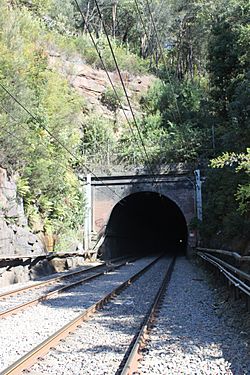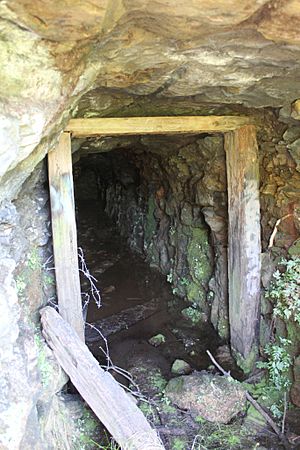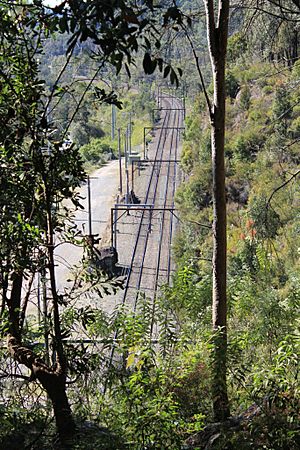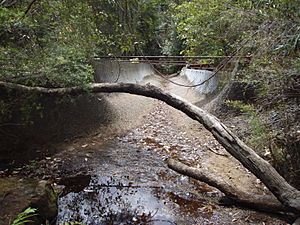Woy Woy Tunnel facts for kids
 |
|
| Northern portal of the tunnel | |
| Overview | |
|---|---|
| Location | Woy Woy, New South Wales, Australia |
| Coordinates | 33°29′27″S 151°16′56″E / 33.490946°S 151.282199°E |
| Start | 1 March 1884 |
| Operation | |
| Owner | Transport Asset Holding Entity |
| Operator | NSW TrainLink |
| Technical | |
| Design engineer | George Blunt |
| Line length | 1 mile 4 chains (1.69 km) |
| No. of tracks | 2 |
| Gauge | 4 ft 8 1⁄2 in (1,435 mm) |
The Woy Woy railway tunnel is a special tunnel for trains in New South Wales, Australia. It connects the areas between Wondabyne and Woy Woy stations. This tunnel is part of the important Main Northern railway line.
The Woy Woy Tunnel is 1.69-kilometre (1 mi 4 ch) long. It has two tracks for trains to travel in both directions. It first opened on 16 January 1888. Because of its history and importance, it was added to the New South Wales State Heritage Register on 28 June 2013.
Contents
What the Woy Woy Tunnel Looks Like


The Woy Woy Tunnel is a 1.69-kilometre-long (1 mi 4 ch) double-track railway tunnel. It goes under a sandstone hill. This hill is located between Brisbane Water and Mullet Creek.
The whole tunnel is built from bricks. When it was first built, it already had two tracks. This meant it did not need to be made wider when the railway line was doubled in 1906. The entrances, called portals, are made of brick and are quite simple. The tunnel has a horseshoe shape and is mostly straight. It also has a gentle slope, going down about 1 metre for every 150 metres of length. Long cuts in the rock lead up to both ends of the tunnel.
When it was finished in 1888, the Woy Woy Tunnel was the longest railway tunnel in Australia.
Building the Tunnel: A Big Project
Building the Woy Woy Tunnel was a huge job! Work began on 1 March 1884. There was a special ceremony on 17 July 1886 when the two ends of the tunnel finally met in the middle. The tunnel officially opened on 16 January 1888.
At the entrance during construction, there was a red banner. It had a Latin saying: Labor omnia vincit. This means Hard work conquers all. A hill about 180-metre (600 ft) high sits above the tunnel.
- Non-stop Work: Construction happened day and night, every day except Sundays.
- Workers: About 300 men worked on digging out the tunnel.
- Explosives: They used over 91 tonnes (100 short tons) of gunpowder and 9.1 tonnes (10 short tons) of dynamite.
- Drilling: Ten special rock-drills helped make holes. These drills used air that was squeezed by a 30-kilowatt (40 hp) engine.
- Materials Used: Around 95,200 cubic metres (124,500 cu yd) of rock was dug out. About 10 million bricks were laid, which came from Gore Hill Brickworks. They also used at least 10,000 barrels of cement.
There was a flood in 1887. An engineer named Henry Deane checked the tunnel. He found that a creek above the tunnel had swollen from heavy rain. The water pushed through the creek bed and around the tunnel's brick lining. It came out through small holes in the masonry. Luckily, the tunnel itself was not damaged. To stop future problems, they planned to temporarily move the creek using flumes. Later, they built a permanent solution.
Connecting Sydney and Newcastle
The Woy Woy Tunnel was a key part of building the Homebush-Waratah line. This line connected Sydney to Newcastle. The construction was done in different parts:
- Hornsby to Hawkesbury: 15 mi (24 km), opened 7 April 1887.
- Hawkesbury River Railway Bridge to Mullet Creek: 5 mi (8 km), opened 1 May 1889.
- Mullet Creek to Gosford: 10 mi (16 km), opened 16 January 1888.
- Gosford to Waratah: 50 mi (80 km), opened 15 August 1887.
For a while, passengers could not fully enjoy the tunnel's benefits. This was because the Hawkesbury River railway bridge was not finished yet. Before the bridge opened, people had to get off trains at Hawkesbury River (from the south) or Mullet Creek (from the north). They then took a ferry between these two points to continue their journey. Mullet Creek station was about 400 metres (1,300 ft) north of today's Wondabyne station. It was also about 1.5 kilometres (0.93 mi) from the western entrance of the tunnel.
Train Sizes and Tunnel Changes
The railway line was built with tracks that were 4 ft 8+1⁄2 in (1,435 mm) wide. This is the standard size for trains in many parts of the world. The tunnel was designed for carriages that were 8-foot-4-inch-wide (2.54 m).
Over the years, trains got bigger.
- In 1960, the line through Woy Woy was electrified. This meant electric trains started using it.
- In 1972, double-deck carriages were introduced. These taller trains needed changes to the tunnel. Workers had to remove some bricks from the top corners of the tunnel. They also lowered the track bed.
- In the 1990s, wider trains like the Tangara trains, which are 3 metres (9.8 ft) wide, were allowed through the Woy Woy Tunnel.
Original Plans for the Tunnel
Did you know the Woy Woy Tunnel was almost built in a different spot? In 1881, there were plans to connect the railway lines by going through Long Island and Dangar Island. This route would have included a tunnel through cliffs on the northern bank to Patonga Creek. Then, another tunnel would go through the land between Patonga Creek and Woy Woy Creek. However, this original plan was not chosen.
Why the Tunnel is Important (Heritage Listing)
The Woy Woy Railway Tunnel is very important for its history. When it was built, it was the longest tunnel in Australia. It was seen as one of the two biggest engineering achievements on the Short North line. The other was the Hawkesbury River Rail Bridge. The tunnel was, and still is, a vital part of the railway link between Sydney and Newcastle.
The tunnel also has a special look and feel. It creates a dramatic change in the train journey. When you leave the rugged beauty of Mullet Creek, you enter the tunnel. When you come out, you are in the flat, built-up areas of Woy Woy and Gosford. The tunnel, along with other tunnels and bridges on the Short North line, shows amazing engineering skills. It proves how well people could build railways in difficult areas back then.
The Woy Woy Tunnel was added to the New South Wales State Heritage Register on 28 June 2013. This means it is protected as an important historical site.
- Historical Importance: It shows how railways helped connect Sydney and Newcastle. It was a record-breaking tunnel for its time.
- Design and Skill: It shows the great skills and technology available when it was built. It's part of a group of tunnels and bridges that highlight engineering success in tough terrain. It is still the longest railway tunnel in NSW, not counting the underground network in Sydney's city centre.
- Learning Potential: While the tunnel itself doesn't have much to dig up, the old workers' camps near the Mullet Creek entrance might. These camps could teach us a lot about the lives of railway construction workers. Such large worker camps are rare in NSW.
- Uniqueness: The tunnel is not the only one of its kind, but it is special because it's the longest outside of Sydney's underground network. It's also the oldest tunnel still being used in NSW.
- Good Example: It's a great example of a double-track railway tunnel in NSW.
Safety on the Tracks
Working on or near railway tracks can be dangerous. Over the years, there have been accidents during the tunnel's construction and operation. These incidents highlight the importance of strict safety rules for railway workers and the public. Lessons learned from past events have led to better safety measures. These include clearer warnings for approaching trains and improved visibility in tunnels. Railway companies and unions work together to make sure workers are safe. They want to prevent accidents and protect lives.




